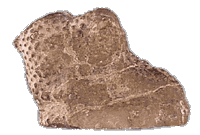



Bryozoa: Fossil Record
|
|
 Stenolaemate Stories
Stenolaemate StoriesThe stenolaemate bryozoans quickly radiated in the early Paleozoic and are very characteristic fossils of Paleozoic rocks, sometimes making substantial contributions to the formation of reefs, calcareous shales, and limestones. They included forms with robust skeletons, such as the trepostome Hallopora pictured above; such forms were common in shallow-water habitats that today are dominated by corals. There were also forms with delicate, branching fanlike skeletons such as the fenestrates pictured below (from the Mississippian of Domodedovo, near Moscow, Russia). With the exception of one order of stenolaemates, the Tubuliporata or Cyclostomata, all of these Paleozoic bryozoan lineages were severely impacted in the Permian extinction: cryptostomates disappeared at the end of the Permian (245 million years ago), while a few other lineages lingered until the end of the Triassic, about 210 million years ago. Tubuliporate bryozoans have survived to this day, and in fact underwent a remarkable radiation in the Cretaceous, but are no longer dominant today.
Gymnolaemate Grandeur |



 The Bryozoa are the only animal phylum with an extensive fossil record that
does not appear in
The Bryozoa are the only animal phylum with an extensive fossil record that
does not appear in